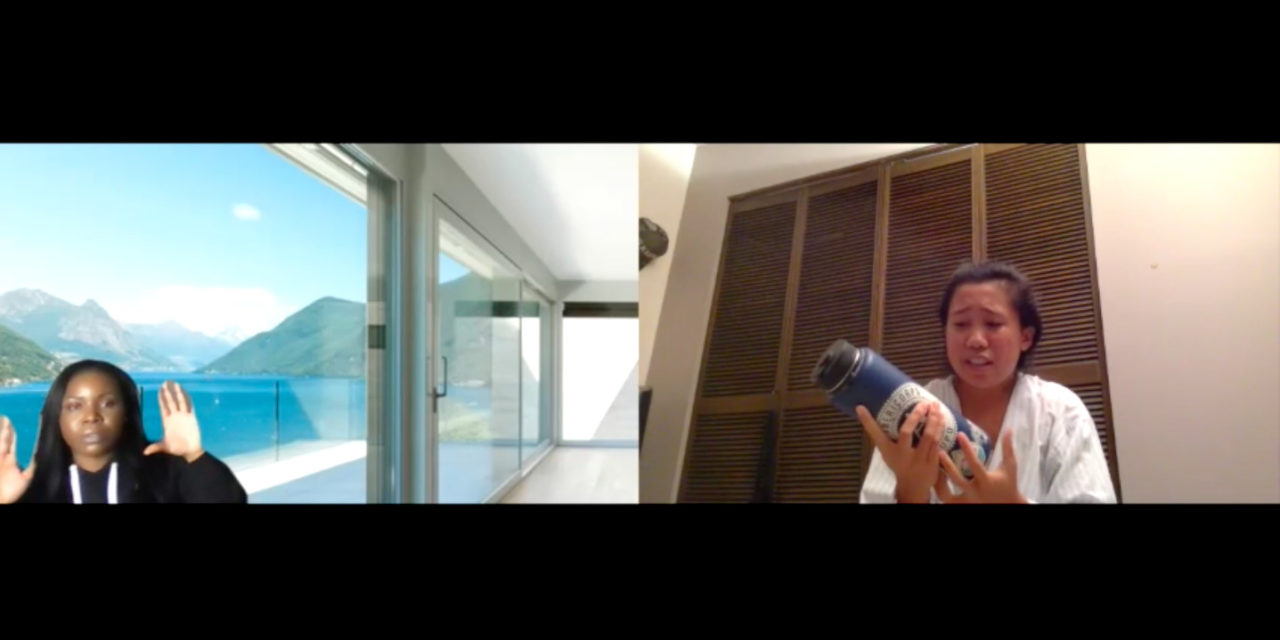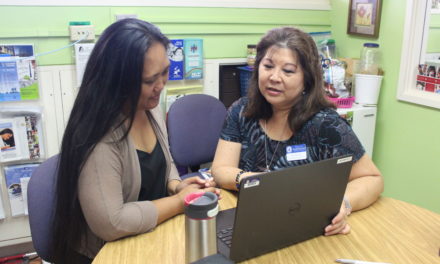Staff Writer | Kiana Dulan
Midterms have passed and with the holiday season just starting, people have become laxer with adhering to Tier 2 restrictions. Although less than five people are allowed to congregate for social gatherings, groups of more than five have occurred, but teachers and students are still not able to physically meet for school. Teachers have gone through a 7-month process of refining their online instruction and with different disciplines calling for different teaching methods, they have found alternative ways to provide curriculum for their students.
Math | MATH 103 | Dayna Kitsuwa
KapCC math teacher Dayna Kitsuwa never taught online before but gives credit to the Teaching Online Prep Program (TOPP) provided by KapCC, which taught a cohort of a dozen teachers in March how to set up a proper Laulima website as well as what to consider while teaching online.
“I feel really blessed that I was able to go through some formal training before being thrown into all of this,” Kitsuwa said. “But going through training versus actually going through [teaching] is different. I feel like you’re always learning things along the way. I’m still learning and adapting, and I feel like that’s how most of us are.”
Students may be used to lectures where the professor drones on and on, but for in-person math classes, Kitsuwa provided an interactive model to teach her students. Before Covid, instead of lecturing the entire period, she used to explain the concepts and give examples and practice problems, then her students would go into small groups to assist each other. Transitioning to this method of teaching online, Kitsuwa found that not everyone’s technology is up to par. Some students would not have their internet, microphone, or camera work.
Making her Math 103 asynchronous with no class meetings, Kitsuwa wondered how she would provide the responsive teaching of her in-person classes. She said she tries to be interactive through forum discussions and homework feedback through a website called Floop. The process of giving feedback to students in this way proved to take longer than her regular system, and she found that she’s dedicating more time to teaching than before.
“It kind of feels like having to learn my profession all over again,” Kitsuwa said. “When I first started teaching, I had very little me time because I had to prep everything. I had to think about how do I want to do this. … It’s kind of gotten back to that.”
The process of reworking the lecture content is the first step; keeping students engaged is the second. From TOPP, Kitsuwa learned about tools to enhance her online teaching methods, but she said it was difficult applying these to practice. Students first had to introduce each other in Padlet, engage in forums to discuss weekly material, and turn in their written work through Floop, which Kitsuwa said helps with engagement since students have to show their work.
After completing their homework, using Padlet and Floop, and participating in discussion forums, students may feel the need to attend office hours. Instead of walking up into the classroom, Kitsuwa’s students can now book an appointment on youcanbook.me. She usually has around one student come in per day, which is the same as sitting in an office. However, Kitsuwa preferred to sit in KapCC’s Study Hub understanding that it would be less daunting for students to see their professor in a public setting versus one on one.
This personal interaction is what she misses the most. Being able to see her students’ reactions when they have finally understood something, from the release of a furrowed brow to hearing her seeing her students’ smiles after she makes a joke, Kitsuwa can’t experience this in scheduled Zoom meetings through the grid of dark screens with student names at the center. However, for exams, the students are required to have a camera pointed at them with Kitsuwa on the other end to ensure that her students are not cheating. She sometimes sees students’ reactions through the process of solving problems, but by then, it is too late to explain the content.
“It’s been a challenge and it’s a work in progress,” Kitsuwa said. “I really just thank all the students for all their patience with [teachers] for doing new things.”
Hawaiian | HAW 101 | Trixy Koide
Trixy Koide is a KapCC Hawaiian teacher who has experience teaching both in-person and online classes. She is currently teaching both first- and second-year Hawaiian students. In her first-year class, students have to answer questions and create their own example sentences using the grammar and vocabulary of that week. In her second-year class, students have to create questions, answers, and dialogue. They have to reach out and communicate with each other, which Koide said is the “best formula” for students’ learning process.
“When you folks grassroots create it on your own, we come in and we just support and facilitate the learning that way,” Koide said.
Like other teachers, Koide finds online-teaching more time-consuming than being in-person. Along with the students she facilitates, she is also the head of the language department and suggests her lecturers keep in mind the number of hours they should expect to work per week.
“Give up this idea that you’re gonna do a 40-hour workweek,” Koide said. “Double that. It’s going to be equivalent to an 80-hour week.”
Other than preparing new material, Koide said she always checks her email and the Laulima website. Emails are constantly coming in, and she said that school policy said to respond to students between 24-48 hours, the act of which can be challenging. When she’s not online, she still finds herself thinking of new ideas for future lessons.
“You could be at home with your family eating dinner and be constantly thinking, ‘Oh. That’s such a great assignment. Let’s ask our students to describe what is on their plate for dinner tonight,’” Koide said. “And the question would be, ‘He aha ke lā no ka ʻāina ahiahi?’”
Although she puts in all this time and effort into her online class, she emphasized that online classes put the responsibility on the students to keep up with their work and stay engaged. She said it is critical for students to communicate with the teacher, and more importantly, each other.
She suggested for students to find people they feel comfortable with through their online interactions and to message a few people instead of the entire class since this increases a student’s chance of getting a response back. Students in her first-year class can resort to Padlet to find audio files or video clips where their fellow classmates post the assigned homework for that week to find a potential study partner. Koide said she also comments on everyone’s post and discussion board after due dates since she found these little responses to positively impact her students. With her asynchronous class, Koide also keeps in mind that everyone has different schedules and responsibilities.
“Students are adults,” Koide said. “Everybody has a life. Everybody is busy, and you folks are struggling with just time management. Time management is huge. For us as kumu, our responsibility is for us to have a schedule with deadlines but also to be flexible.”
Beginning Acting | THEA 221 | Sammie Choy
A student finishes a monologue for her final exam. Instead of roaring applause from classmates, she presses the stop recording button and uploads her video to Padlet. Classmates then comment on how great their performance was, but this delayed feedback can never compare to the instant gratification of an audience reacting to what she worked on for an entire month.
KapCC theater teacher Sammie Choy dabbled with the transition from in-person to synchronous online teaching methods in both Spring and Summer 2020, then moved to asynchronous for this fall semester to try to increase enrollment. She found the Spring 2020 semester to be the best since her students already had a few months to become comfortable with each other. They knew how to make each other tick, and this intimacy is non-existent for this semester’s students who have only seen each other through the screen.
When performing, actors usually play with their partner’s energy to achieve an emotional scene, but performing through a recorded Zoom meeting is not as personal, no matter how hard both people try. Choy said that looking at someone’s eyes is important. Interacting through the computer prohibits that because for a student to “look” into their acting partner’s eyes, they have to look at the computer’s camera instead of the person themselves. This divide is not the only technical difficulty present in Choy’s acting class.
Along with this separateness, Choy said that some students have had to resort to writing papers on their cell phones. Other students live in close quarters with their family or roommates, so performing a dramatic scene is difficult without any privacy. Not only is this academic stressor present in people’s lives, but Choy said that her students have also had to deal with other challenges such as losing jobs during the pandemic.
Through these online classes, Choy familiarized herself with her students through their Padlet videos and office hour. The process of transitioning to this new way of interacting with her students proved time-consuming. In her other class, Introduction to Acting, where she teaches theater history, theater theory, costuming, and set design, she finds it easier to teach than her online class because she is specifically trained in those areas. She has never taught an on-camera acting class.
She said that other acting teachers nationwide luckily started multiple Facebook and discussion groups to share teaching ideas and practical examples of how to teach online. After this semester, she hopes to teach at the Maile building, which is the classroom for theater acting classes. She did this in the summer semester where she synchronously led warm-ups, theater games, stretching, pushups, and planks through Zoom.
“I would set up the camera and the computer so that they could see my whole body, but not everyone has room at home,” Choy said. “Sometimes I would have them do a yoga position, and it would just be [a student’s] arms sticking up. I would trust that they were being safe and not pushing themselves too hard.”
In her current asynchronous class, students now interact with each other by watching more than the required two videos they are supposed to comment on. Choy views this as valuable for her students because they can become familiar with their classmates and view their gradual improvement as the semester goes on. Although she has never met her students in person, she still extends a helpful sentiment to her students.
“Be really good to yourselves,” Choy said. “There are so many stressors in our lives right now. Not just the strain of being alone so much while not being in class to connect with your fellow students, but politically, there are a lot of stressors now. Life is stressful. Eat chocolate, go swimming. Whatever it is, if that’s your jam, do it.”






